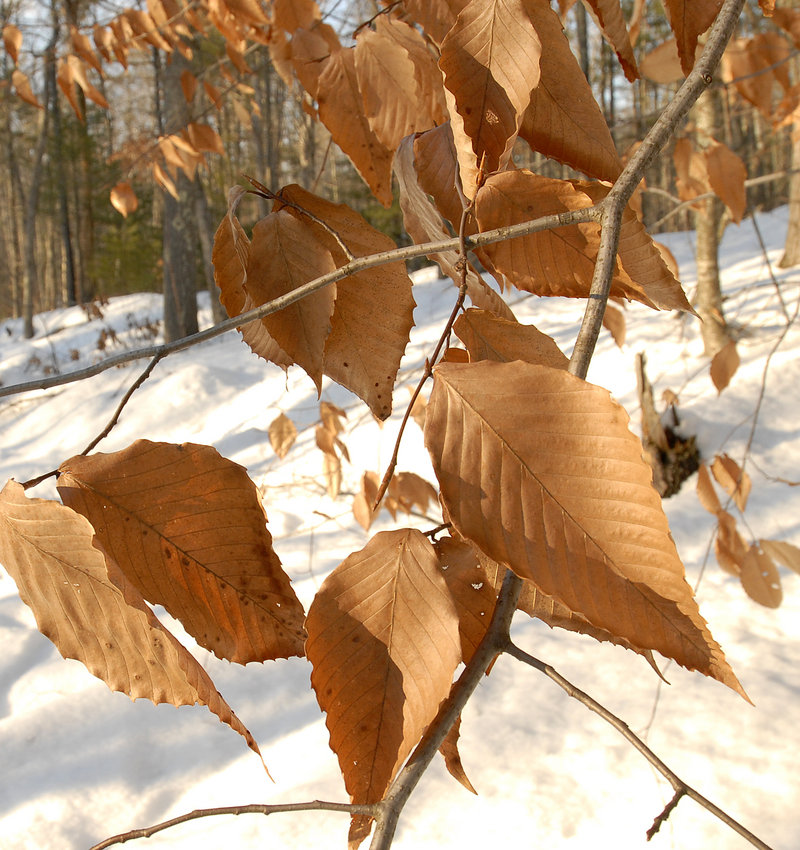In my lifetime, an explosion of enlightened, meticulous nature research has shown up in magazines and books, written for laymen. Indeed, the accumulated wisdom of the world’s naturalists lies at our fingertips, making the 21st century an exciting time to live.
In contrast, during my early youth, the average outdoor wanderer’s knowledge of nature included myriad unsubstantiated opinions, some of them out and out goofy conclusions.
Three examples follow, and the first one pops to mind each winter as I slip through beech saplings and mature beech laden with tan leaves.
When past generations observed this deciduous tree holding foliage through the white season, they called it “winter beech” as if it were a different species than summer beech. It wasn’t.
These woodsmen even included an explanation with their misnomer, claiming nature was creating cover so deer could survive winter. That specious comment sounds ever so logical, but research has proven a more scientific conclusion, beginning with the fact deer winter under conifer canopies, not in tightly growing beech saplings.
In truth, researchers have proven Maine trees such as beech and also red oak keep leaves through winter, a wonderful survival strategy.
Scientists describe this tactic with the $20 word “marcescence,” meaning “withering but not falling off.”
Here’s why beech and red oak choose this strategy: They often grow in sterile, dry soil on ridges, so to combat limited fecundity, nature keeps the leaves before shedding them in early spring, providing fresh mulch that rots through spring and summer. This gives nourishment in the growing season when these hardwoods need it.
Besides producing mulch, winter leaves also offer cover for insect larvae that hunker down in the curled, withered leaves, offering food for birds, carnivorous insects and so forth. This last one falls more under a symbiotic relationship than self-perpetuation.
Roughly speaking, this evolutionary tactic of keeping leaves through winter places beech, oak and similar plants between conifer and deciduous. Most hardwood species discard leaves in fall, and conifers often drop one-year class of needles in November and keep the remaining year classes intact on their branches. The other year classes keep conifers green all winter.
However, even one-year class of needles dropping to the ground creates a brown carpet, requiring raking on lawns.
The second example involves white pine, which often springs up on somewhat sterile ridges under a beech and oak canopy.
This topic hits on one of my theories that I have never seen in nature books. White-pine needles look round, but careful observation reveals a trilobal configuration.
Needles with three flat sides reflect more light than cylindrical needles, as most fly tiers know. We choose trilobal yarn for bodies on caddis imitations, a fiber that really bounces light to attract fish.
In my humble opinion, pines grow in dry soil, so needles must reflect light in summer droughts to conserve moisture. In fact, most conifer needles have flat surfaces — two-, three- and four-sided. White pine evolved with three.
The third example offers a classic example of goofy folklore, folklore that crosses my mind each spring.
The topic involves a common Maine ground plant that flourishes under mixed-growth canopies in suitable habitat. In the juvenile stage, the rich, maroon color of the shiny, ovate, finely toothed leaves and same color stem show up against the drab landscape before spring’s viridescent explosion. This plant grows three leaves to a stalk, but it occasionally produces five leaves per cluster after it reaches seven to 10 days old.
When I turned 5 and info stuck in the brain like a bad dream, my family and circle of acquaintances called this plant “poison mercury.” A clich?bout toxic plants fit into the misidentification: “three shiny leaves … let it be.”
Not long after these plants emerge from the ground, they seemingly disappear as 8- to 15-inch solid green plants with five leaves per stalk take their place, covering the forest floor, looking like small umbrellas.
The new green plants, the mature form of the juvenile maroon ones, are common Maine plants in the ginseng family: wild sarsaparilla (Aralia nudiccaulis). In maturity, they produce greenish-white flowers.
Wild sarsaparilla produces no toxic qualities and, in fact, a closely related species grows in tropical climates, a major ingredient in sarsaparilla and root beer beverages.
Ken Allen of Belgrade Lakes is a writer, editor and photographer. He can be contacted at:
KAllyn800@yahoo.com
Copy the Story Link
Send questions/comments to the editors.



Success. Please wait for the page to reload. If the page does not reload within 5 seconds, please refresh the page.
Enter your email and password to access comments.
Hi, to comment on stories you must . This profile is in addition to your subscription and website login.
Already have a commenting profile? .
Invalid username/password.
Please check your email to confirm and complete your registration.
Only subscribers are eligible to post comments. Please subscribe or login first for digital access. Here’s why.
Use the form below to reset your password. When you've submitted your account email, we will send an email with a reset code.